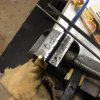I'm conflicted on that?
The 12 1/8" pins are for sure alignment pins and will be bonded in place when the scales go together.
The 1/4" lanyard pin hole is going to serve as an epoxy & air bleed hole until after the two scales are bonded together.
Normally, I would assemble the scales on the tang and pins with epoxy.
And pin or bolt the scales to the tang.
Then flat sand the pins & bolts down flush with the scales and guard.
Then do final shaping with the guard with drum sanders, sand-paper strip strips, hand sanding, then progressively finer buffing wheels.
This one though???
After I do the Silver inlays in the guard, I can't flat sand the scales to the guard without sanding the Silver inlays off!!!
So, thinking outside the box, I am planning to glue the scales & pins together off the knife.
Then flat sand, fit to the guard, & finish buffing them.
Then fill the hole with epoxy, and force the tang in.
The 'weep holes' will allow excess epoxy & air to bleed out through the unfinished lanyard holes.
After the Epoxy sets, I can drill any excess epoxy out of the lanyard hole and put the fancy liners in.
Or, I could assemble it to the knife with epoxy & tang pins, then try to find a way to flat sand the junk off without ruining the silver inlaid guard???
You see the logic I'm coming from?
I don't think I can do it the normal way because of the silver inlayed guard??
Anyway, epoxied and force fit in the assembled handle, with air bleed hole to let the air escape would give me 100% total epoxy bond.
I don't think it's coming off in 500 years done that way!!
Or, I could pre-drill the two tang holes for 1/8 pins and plug them with wood plugs.
Then re-drill them after the epoxy sets and pin the handle to the tang then??
But, I have plans for that wide expanse of ivory slab with no pins in the middle.
(More old tricks I still may have in the bag of tricks??)
Opinions?
It's not too late to change my assembly plans yet!!
rc











